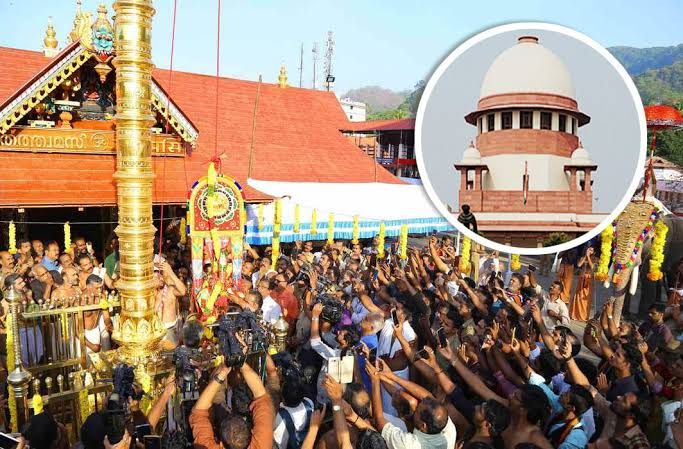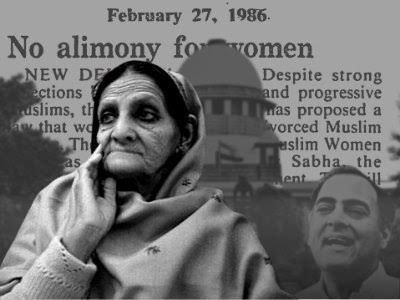Author: Tapaja Maiti a student of Haldia Law College.
Abstract:
The Sabarimala temple case is a landmark legal battle in India that underscores the tension between religious, tradition and constitutional rights and particularly gender equality. Historically the Sabarimala temple in Kerala enforced a ban on the entry of women of menstruating age, citing the celibate nature of the deity Lord Ayyappa. This practice was challenged in the Supreme Court of India leading to a historic judgment in September 2018 that lifted the ban deeming it unconstitutional and discriminatory. The case raised many questions about the intersection of religious practices, gender discrimination and constitutional principles.
INTRODUCTION:
Freedom has been achieved long ago but stereotype behavior prevails towards women till this date. Women despite significant progress still face various forms of discrimination and inequality compared to men. While there have been advancements in many areas including education, employment and political representation, gender disparities persist. Women often encounter barriers in accessing equal opportunities and rights. Issues such as the gender pay gap, underrepresentation in leadership positions, lack of access to reproductive healthcare and gender-based violence highlight the ongoing challenges women face in achieving full equality. Achieving true gender equality requires addressing challenging stereotypes and fostering cultural shifts that value and respect the rights and contributions of women compare with men.
The Sabarimala temple case represents a landmark moment in the struggle for women’s rights in India. The case is a landmark legal battle that has captured national and international attention. The Supreme Court’s verdict not only rectified a historic injustice but also paved the way for greater gender equality. Covering several years the case has been characterized by debates, protests, legal proceedings and a significant Supreme Court’s decision that has left a lasting impact on Indian society.
Historical Background:
The Sabarimala temple situated in the Western Ghats of Kerala is one of the most revered pilgrimage sites in India drawing millions of devotees each year. Dedicated to Lord Ayyappa, the temple is known for its strict celibacy tradition with women of menstruating age (10 -50 years) historically barred from entering the temple premises. This practice was based on the belief that the presence of women of reproductive age would disrupt the celibate nature of the deity and defile the sanctity of the temple.
Legal Proceedings:
The Indian Young Lawyers Association filed the petition in the Supreme Court of India in 2006 challenging the ban on the entry of women of menstruating age into the Sabarimala temple.The reason behind filing such a petition was to address what they perceived as a discriminatory and unconstitutional practice. They argued that the ban violated women’s fundamental rights as equality, liberty, and religious freedom as well as Articles 14, 15, 19(1), 21, and 25 under the Indian Constitution. The Indian Young Lawyers Association sought to challenge entrenched patriarchal norms and advocate for the recognition and protection of women’s rights in religious spaces.
Over the years, the case underwent various twists and turns with hearings, petitions and interventions from different stakeholders representing diverse perspectives. In September 2018 the Supreme Court delivered a historic judgment by a majority of 4-1 lifting the ban on the entry of women of menstruating age into the Sabarimala temple. The court held that the practice was unconstitutional and discriminatory violating women’s fundamental rights to equality and freedom of religion under the Indian Constitution.
Fact and Issue:
- The case brought to the forefront the tension between constitutional rights, such as gender equality and freedom of religion and religious practices rooted in tradition and belief.
- The ban on women’s entry into the temple based on their biological characteristics was seen as a form of gender discrimination and denying women equal access to religious spaces and practices.
- The case sparked debates about the relevance of age-old traditions in a modern, democratic society with some arguing for the preservation of cultural practices and others advocating for progressive reform.
- The Supreme Court’s intervention in religious matters raised questions about the extent of judicial activism and its impact on religious autonomy and cultural diversity.
Argument points between Petitioner and Respondent:
Petitioner (Advocating for Gender Equality):
- Constitutional Rights: The ban on women’s entry into the Sabarimala temple violates women’s fundamental rights to equality and freedom of religion guaranteed under the Indian Constitution. It perpetuates gender discrimination and denies women equal access to religious spaces based on their biological characteristics.
- Discriminatory Practice: Barring women of menstruating age from entering the temple is a discriminatory practice that reinforces patriarchal norms and denies women full participation in religious rituals and traditions. It undermines their dignity as equal citizens.
- Modern Interpretation: We advocate for a modern interpretation of religious practices that aligns with contemporary notions of equality and justice. Religious customs and traditions must evolve to reflect changing social realities and uphold fundamental rights, including gender equality.
- Social Progress: Upholding the ban on women’s entry into the Sabarimala temple perpetuates outdated and regressive attitudes towards women. It hinders progress towards gender equality and undermines efforts to promote inclusivity and diversity in religious spaces.
Respondent (Defending Temple Traditions):
- Religious Autonomy: The Sabarimala temple’s tradition of barring women of menstruating age is an integral aspect of its religious practices and beliefs. It is based on centuries-old customs and rituals that are deeply ingrained in our cultural and religious heritage.
- Preservation of Tradition: The ban on women’s entry into the temple is not discriminatory but rather a matter of preserving the sanctity and purity of the temple’s deity Lord Ayyappa, who is believed to be celibate. Allowing women of reproductive age to enter would violate this sacred tradition.
- Respect for Religious Beliefs: Upholding the ban on women’s entry into the Sabarimala temple is essential for respecting the religious sentiments and beliefs of millions of devotees who hold the temple’s traditions sacred. It is a matter of religious freedom and autonomy.
- Cultural Identity: The Sabarimala temple’s customs and traditions are an integral part of Kerala’s cultural identity and heritage. Any attempt to alter or abolish these traditions would undermine the unique cultural fabric of the region and erode its rich religious heritage.
Supreme Court judgement:
(Indian Young Lawyers Association & Ors. v. State of Kerala & Ors.)
Citation(s)- WRIT PETITION (CIVIL) NO. 373 OF 2006
The five-judge bench of the Supreme Court Chief Justice of India Dipak Misra, Justice A.M. Khanwilkar, Justice Rohinton Fali Nariman, Justice D.Y. Chandrachud and Justice Indu Malhotra delivered the judgment in the Sabarimala temple case on September 28, 2018.
The five-judge bench delivered separate opinions:-
- Chief Justice Dipak Misra’s opinion: Chief Justice Misra held that the ban on the entry of women of menstruating age into the Sabarimala temple was unconstitutional and discriminatory. He emphasized the principles of equality and non-discrimination enshrined in the Indian Constitution asserting that religious customs and traditions cannot override fundamental rights.
- Justice Rohinton Fali Nariman’s opinion: Justice Nariman concurred with the majority opinion and authored a separate opinion supporting the decision to lift the ban on women’s entry into the Sabarimala temple. He underscored the importance of upholding constitutional values and ensuring equal access to religious spaces for all individuals, regardless of gender.
- Justice A.M. Khanwilkar’s opinion: Justice Khanwilkar affirming the unconstitutionality of the ban on women’s entry into the Sabarimala temple. While his opinion did not provide additional details it supported the overall reasoning and conclusion of the majority judgment.
- Justice D.Y. Chandrachud’s opinion: Justice Chandrachud elaborating on the constitutional principles involved in the case. He emphasized the importance of equality and non-discrimination in religious matters and also stating that religious practices cannot be used as a basis for perpetuating gender inequality.
- Justice Indu Malhotra’s opinion: Justice Malhotra upheld the ban on women’s entry into the Sabarimala temple. In her opinion she emphasized the significance of religious practices and traditions, arguing that courts should not interfere in matters of religion unless there is a clear violation of fundamental rights. She stated “It is not for the courts to determine which of these religious practices are to be set down, unless they are harmful, repressive, or a social ill, like Sati.”
Five judge bench majority concluded that the banning women from entering in the Sabarimala temple in their puberty age is violation of their fundamental right. The majority of judges didn’t comment on the tradition and customs violating the right to equality (article 14) but they did state that the custom is discriminatory under article 21.
In a 4-1 decision, The court lifted the ban on the entry of women of menstruating age into the Sabarimala temple in Kerala overturning centuries-old tradition. The majority decision was based on principles of equality and non-discrimination.
The Supreme Court has permitted women of all ages to enter the Sabarimala Temple ruling that “devotion cannot be subjected to gender discrimination.”
There were more than 50 petitions in 2018 for review, the petitions were filed by various organisations named- the National Ayyappa Devotees (Women’s) Association, the Nair Service Society and the All Kerala Brahmins Association. On November 13th 2018, the Court resumed hearing the review petitions in open court. By the time Chief Justice Dipak Misra had retired and Chief Justice Ranjan Gogoi replaced him on the Bench.
On November 14th 2019, In a 3-2 majority the Bench delivered a Judgment keeping the review petitions pending. The Other freedom of religion cases may object to the reasoning in the Sabarimala Judgment of 2018, they referred certain widespread constitutional questions to a larger Nine Judge Bench. These widespread issues affect women’s access to public holy religious institutions.
Latest Judgment (2020):
On February 10th 2020, a nine judge bench of the Supreme Court delivered its verdict on the Sabarimala temple case. In a complex and nuanced judgment the bench upheld the right of women of all ages to enter the temple reaffirming principles of gender equality and constitutional rights. The court emphasized that notions of purity and pollution cannot be grounds for discrimination and religious practices must evolve with societal values.
CONCLUSION:
Despite the Supreme Court’s verdict, challenges remain in implementing the judgment effectively. Cultural and religious attitudes are deeply entrenched and changing centuries-old practices requires sustained efforts in education, awareness and social reform. The Sabarimala temple case serves as a reminder of the complexities inherent in navigating the intersection of religion, tradition and modernity in a diverse and pluralistic society like India. The case stands as a testament to the enduring struggle for gender equality and individual rights. From the courtroom to the streets it has ignited impassioned debates and prompted soul-searching across the nation. As India continues its journey towards progress and inclusivity the Sabarimala verdict serves as a guiding light illuminating the path towards a more just and equitable society for all.
Legal jargon:
Advocate, Case, Court, Defendant, Judge, Supreme Court, Verdict.
References:
- https://primelegal.in/2022/11/25/the-sabarimala-case-the-supreme-court-of-india/
- https://www.scobserver.in/cases/indian-young-lawyers-association-v-state-of-kerala-sabarimala-temple-entry-background/
FAQs
1.Should women be allowed inside the shrine and the temple Sabarimala?
Ans.
Yes, on September 8th 2018, the supreme court gave the judgment irrespective of gender and age.
2.For how long women have to fight for equal rights as men?
Ans.
The struggle for equal rights for women has been ongoing for centuries and continues today. While significant progress has been made in many areas including education, employment, and political representation there are still gaps and challenges to overcome. It’s a journey that requires collective action and a commitment to justice and fairness for all.





